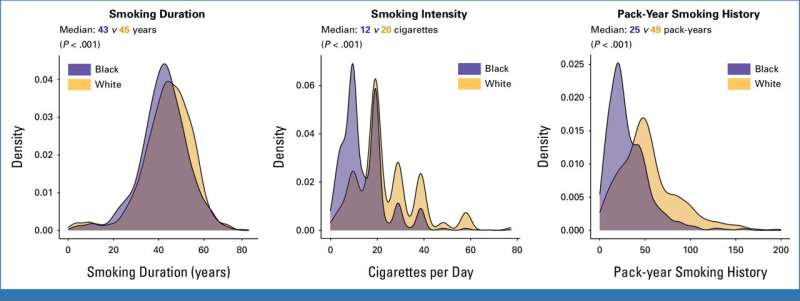This article has been reviewed according to Science X's editorial process and policies. Editors have highlighted the following attributes while ensuring the content's credibility:
fact-checked
peer-reviewed publication
trusted source
proofread
Proposed lung cancer screening guideline could eliminate racial disparities, allow for early detection

Early detection of lung cancer through low-dose computed tomography screening is one of the most promising strategies to reduce lung cancer mortality among high-risk individuals.
The U.S. Preventative Services Task Force currently recommends annual lung cancerscreening for adults aged 50 to 80, who have at least a 20-pack-year smoking history (one pack year is the equivalent of smoking an average of 20 cigarettes per day for a year), and who either currently smoke or quit smoking within the last 15 years.
However, the use of pack-year smoking history as a measure for lung cancer risk has been criticized on the grounds that it incorrectly assumes that smoking intensity and duration have equal importance in determining lung cancer risk.
Previous studies have shown that smoking duration is more strongly associated with lung cancer risk compared to smoking intensity.
As a result, the use of pack-year smoking history to select individuals for screening may exclude many individuals at high risk for lung cancer by underestimating lung cancer risk among those who smoke less intensely (i.e., fewer cigarettes per day), such as individuals from racial and ethnic minority groups.
In a recent study published in the Journal of Clinical Oncology shows that a new proposed guideline—that is the same as the USPSTF guideline but replaces the 20-pack-year requirement with a 20-year smoking duration requirement—increases the proportion of lung cancer patients who would have qualified for screening and eliminates the racial disparity in screening eligibility between Black versus white individuals.
The team of researchers was led by co-senior authors Chi-Fu (Jeffrey) Yang, MD, of Mass General Cancer Center, a founding member of the Mass General Brigham health care system, and Julie Palmer, ScD, from the Boston University (BU) Chobanian & Avedisian School of Medicine.
"Our findings challenge the use of pack-year smoking history in determining lung cancer screening eligibility and support the use of smoking duration cutoffs, instead, as a simple yet effective change to increase the sensitivity of the guideline and improve equity in opportunities for screening," says Yang, a physician-investigator in the Department of Surgery at Mass General and an associate professor of Surgery at Harvard Medical School.
"It is critical that Black Americans, who experience a disproportionately high rate of lung cancer mortality, have improved access to lung cancer screening, one of the most promising strategies for reducing lung cancer deaths among high-risk individuals," says Palmer, director of the BU Slone Epidemiology Center and a professor of Medicine at the BU Chobanian & Avedisian School of Medicine.
For their study, the researchers analyzed 49,703 individuals with a smoking history from the Southern Community Cohort Study and 22,126 individuals with a smoking history from the BU Black Women's Health Study to assess eligibility for screening under the current USPSTF guideline and under the new proposed guideline based on smoking duration.
Under the current USPSTF guideline, only 57.6% of Black patients with lung cancer in the SCCS would have qualified for screening, whereas 74.0% of white patients with lung cancer would have qualified, the researchers write.
Under the new proposed guideline based on smoking duration, the percentage of Black patients eligible for lung cancer screening increased from 57.6% to 85.3%, while the percentage of white patients eligible for lung cancer screening increased from 74.0% to 82.0%
In the Black Women's Health Study, replacing the 20-pack-year cutoff in the current USPSTF guideline with a 20-year smoking duration cutoff increased the percentage of Black women with lung cancer who would have qualified for screening from 42.5% to 63.8%.
These findings suggest that revising the USPSTF criteria to include a 20-year smoking duration cutoff, instead of a 20-pack-year cutoff, would be an important step forward to eliminate racial disparities in lung cancer screening eligibility and would contribute to the advancement of ongoing efforts by the USPSTF to address systemic bias in preventive service recommendations.
"We hope the findings of the present study inspire conversation around disparities in lung cancer screening eligibility and encourage the United States Preventive Services Task Force to reconsider the use of pack-year smoking history to determine lung cancer screening eligibility," says Yang.
More information: Alexandra L. Potter et al, Pack-Year Smoking History: An Inadequate and Biased Measure to Determine Lung Cancer Screening Eligibility, Journal of Clinical Oncology (2024). DOI: 10.1200/JCO.23.01780



















